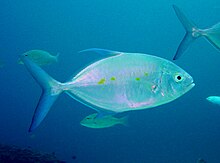| Island trevally | |
|---|---|

| |
| Scientific classification | |
| Domain: | Eukaryota |
| Kingdom: | Animalia |
| Phylum: | Chordata |
| Class: | Actinopterygii |
| Order: | Carangiformes |
| Family: | Carangidae |
| Genus: | Carangoides |
| Species: | C. orthogrammus
|
| Binomial name | |
| Carangoides orthogrammus (D. S. Jordan & C. H. Gilbert, 1881)
| |

| |
| Approximate range of the island trevally | |
| Synonyms | |
| |
The island trevally, island jack, thicklip trevally or false bluefin trevally (Carangoides orthogrammus) is a widespread species of offshore marine fish classified in the jack family Carangidae. The island trevally is common through the tropical regions of the Indian and Pacific Oceans, ranging from Mozambique and the Seychelles in the west to Hawaii and the Revillagigedo Islands in the central and eastern Pacific. The species is almost completely absent from the continental shelves, instead inhabiting offshore islands, where it is found in lagoons and on reef systems. It is a moderately large fish, growing to a maximum recorded length of 75 cm and 6.6 kg in weight, and is distinguishable by its angular snout and yellow spots, as well as more detailed anatomical features. The island trevally often moves in small schools, preying on a variety of small fishes and crustaceans. It is of moderate importance to fisheries throughout its range, often taken by trawls, hook-and-line, and various inshore netting methods, and is sold fresh or salted at market.
- ^ Smith-Vaniz, W.F. & Williams, I. (2017) [errata version of 2016 assessment]. "Carangoides orthogrammus". IUCN Red List of Threatened Species. 2016: e.T20429869A115375664. doi:10.2305/IUCN.UK.2016-3.RLTS.T20429869A65927753.en.
